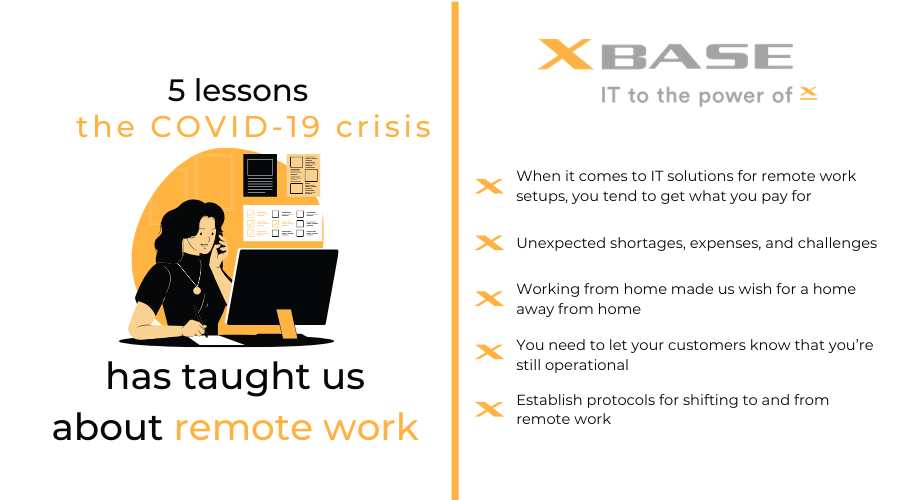As of this writing, Canada’s provinces are carefully reopening so as to revitalize their economies without suffering a resurgence of COVID-19 infections. Stay-at-home orders have been brutal to many non-essential businesses, so having these lifted is a welcome change. Fortunately, some have been allowed to continue operating as long as their employees work from home.
Home-based work is not new, though the pandemic has served to highlight the benefits of telecommuting. And now that office workers can return to their desks, it’s time to take a quick look back at our collective remote work experience and glean a few lessons from it.
#1 When it comes to IT solutions for remote work setups, you tend to get what you pay for
Video conferencing is the go-to method for remote workers to meet. Most apps for this have free trial versions or have free versions that greatly limit the number of participants and conference times, so when Zoom burst into the scene with its generously-outfitted free version, people lapped it up.
However, being “free” did come at a price: lax security. Somehow, hackers were able to interrupt live video streams with inappropriate and sometimes disturbing content. Termed “Zoombombing,” these incidents caused many companies to ban Zoom and look for alternatives. Zoom claims to have improved its cybersecurity with its latest version, but online video hijackers apparently upped their antics, too.
With the global economy on a downturn, the promise of saving money by using free IT solutions is immensely appealing. However, be aware of the risks you’ll expose your company to if you do use these.
Beware of unsecure IT. Learn how you can enjoy safe and Exponentially Better™ IT infrastructure without having to make large capital expenditures.
#2 Unexpected shortages, expenses, and challenges
Working from home is a solution that introduced tough execution problems:
- Getting enough VPN licenses – Having staff use VPNs is a good cybersecurity measure, but they do require the proper amount of licensing for all users accessing them. This caused some delay and expense as companies had to secure sufficient licenses to support all work-from-home staff. Looking forward, it’s likely that more budget will need to be allocated to VPN licensing so that staff can seamlessly transition between working at the office and from home.
- Providing staff with work-from-home equipment – It’s easy to make the assumption that everyone has the capability to work from home, but the fallacy of this assumption soon became apparent, as companies scrambled to get devices, headsets, and even some networking gear for their employees. Laptops, in particular, soon became scarce, with some firms reporting that desired models are still on backorder two months into the crisis. While many organizations have now secured the gear they need, equipping all future employees with the capability to work from home with company devices may become a business continuity policy.
#3 Working from home made us wish for a home away from home
Our homes are where we forget about work, relax, and recharge. So while telecommuting is a godsend for staff, managers, and business owners during pandemic lockdowns, working from home brings a lot of stressors beyond the work itself:
- Coordinating with team mates can be very difficult as people work at different hours of the day and unpredictably stay away from their keyboards during their shifts.
- Staff members needed to learn how to use new communication and productivity apps, how to report progress on their tasks, and who to contact for particular concerns, while managers dealt with how to keep the company safe from cyberthreats, measuring performance, maintaining project schedules, and the general well-being of their staff.
Related article: Please be aware of Covid-19 phishing attempts
- Doing too many video calls is exhausting for the brain.
- Because the line between home and work is blurred in a work-from-home setup, people tend to overwork and become more prone to burnout.
- Choosing a Zoom background is hard!
#4 You need to let your customers know that you’re still operational
Yes, remote work lets your company keep on running, but if your customers don’t know that you’re still open, then letting employees work from home may be all for naught.
Update your social media accounts and website’s homepage to say that you’ve shifted to a particular work setup, and that the transition may affect the promptness or quality of your service. Email a newsletter telling your customers that despite setbacks, you remain committed to serving them. And as Canadian federal and provincial governments change their policies with respect to the pandemic, update your customers on how these changes will affect them.
Related article: Remote working: Will it be the new norm?
#5 Establish protocols for shifting to and from remote work
History teaches us that pandemics can come in waves. If there’s a resurgence of COVID-19 infections, then businesses might have to shift back to implementing home-based work policies. If so, having clear-cut protocols on switching to telecommuting would make future transitions quicker and less costly.
XBASE helps businesses in Toronto leverage the benefits of telecommuting. If you’re interested in establishing your own remote work policies but don’t know where to begin, consult with our IT specialists today.
Do you need help with your IT needs?
Like This Article?
Sign up below and once a month we'll send you a roundup of our most popular posts

